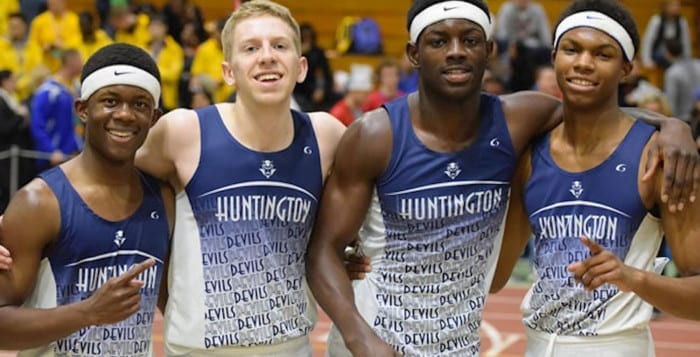Forget about being county and state champions, the Huntington boys’ winter track 4×400-meter relay team raced a nation-best 3 minutes, 16.09 seconds at the New Balance Nationals Indoor.
At the Armory in Manhattan, the team topped its previous best mark for the third fastest time ever in New York, and ninth fastest ever nationally. The time also set a new Suffolk County record.
Kyree Johnson ran his quarter in 48.887 seconds, Shane McGuire finished in 49.701 and Lawrence Leake finished the third leg in 49.802, to put the Blue Devils in a position to win. And Infinite Tucker made it happen, turning in a blistering-fast time of 47.708 seconds on the fourth and final leg.
“We won because of hard work and dedication,” Johnson said. “We did it as a family and as a team.”
 Huntington’s time was slightly more than one second off the fastest mark ever at the New Balance Indoor Nationals and three seconds off the national record of 3:13.06 set by North Carolina’s New Bern High School in 2009.
Huntington’s time was slightly more than one second off the fastest mark ever at the New Balance Indoor Nationals and three seconds off the national record of 3:13.06 set by North Carolina’s New Bern High School in 2009.
Huntington’s 1600 sprint medley relay team captured All-American honors as well. Johnson, Leake, McGuire and Tucker finished in a time of 3:30.94 to place sixth in a strong field of 22 behind elite teams from Virginia, Michigan, Louisiana, Massachusetts and North Carolina. The Blue Devils All-American performance marks a new Suffolk County record in the event and is the fastest time in New York State this year.
Johnson and Leake ran the first two legs consisting of 200 meters each, followed by Tucker handling the third leg of 400 and McGuire running the anchor leg of 800.
The school also finished 11th in a field of 45 in the 4×200 relay. The squad’s time of 1:29.68 tied the Suffolk record set by Amityville in 2003. Johnson, Leake, Tucker and Exzayvian Crowell ran the race for the Blue Devils.
“What can you say about these four young men that have been blessed with a rare talent?” Huntington’s head coach Ron Wilson asked of his 4×400 relay team. “They gave this race everything they had and look at what they were able to accomplish. They have made our school and community proud and put Huntington track on the national map.”
Weeks prior, at the New York State Indoor Track & Field Championships at Cornell University, the Blue Devils kept Huntington track on the state map.
The quartet successfully defended its state title from last season with a time of 3:24.02, well off its previous season best before nationals, which was 3:17.36, notched in February at the Millrose Games, but it was still faster than any other relay team in New York.
“From the bus ride up, the only thought in my head was to win,” Johnson said. “Everything was strictly business from then until it was over. Coming home as a two-time state champion was definitely a major goal, but I also wanted to win the 55-meter dash because it was all up to me in that race. After coming in a close second in the 55, I knew I had to let go of that and give all my focus to the 4×400 relay. Seeing your team cross the finish line first again at the state championships is one of the best feelings around.”
Johnson was nipped by 1/100th of a second, clocking in a 6.40 just behind Rochester’s Wilson Magnet senior Kelly Brown.
Johnson wasn’t the only Blue Devil that Brown challenged.
Brown also raced Tucker to try and claim gold. This time, the Blue Devils came out on top, as Tucker won a gold medal in the 55-meter hurdles after clipping the final hurdle and sending it flying before he dove over the finish line. He outraced Brown by 2/1000ths of a second, and his time of 7.38 was seconds off his best of the winter, but good enough for the crown.
Tucker also claimed a silver medal in the long jump. Seeded sixth, the Blue Devils star leaped 23-01.75 feet on his fifth and final jump to finish behind Beacon senior Terrel Davis, who won by soaring 23-07.00 feet.
“Individually we are like a drop of water, but together we are an ocean,” Tucker said. “If there’s one thing that I learned from Coach Wilson and [assistant coach Eli] Acosta, it’s that hard work beats talent when talent doesn’t work hard.”
During a March 21 board of education meeting, Superintendent Jim Polansky recognized the boys’ track team for all of its success.
“These kids continue to perform at the highest of levels,” he said. “What really makes us excited about the four of them, if you listen to the interview following the race, what they have to say about all of their experiences in Huntington and their coaches and the staff and just the humility they display, it really makes it all worthwhile.”
With multiple medals around their necks, it’s been worthwhile for the Blue Devils, too.
Alex Petroski contributed reporting.

















